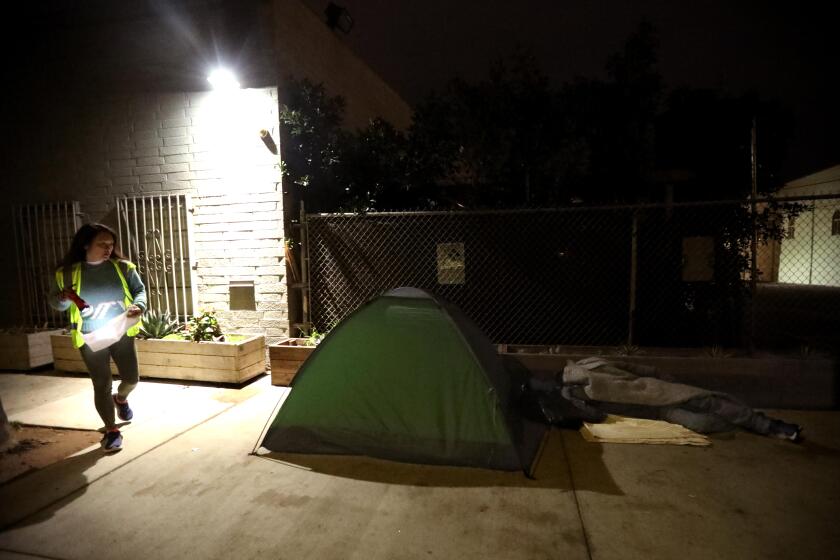Editorial: California’s next affordable housing crisis is the rising cost of property insurance

California has spent billions of dollars in recent years to build desperately needed housing for homeless and low-income tenants. Now a growing problem for the state’s homeowners has hit affordable housing providers especially hard: skyrocketing property insurance rates.
In the last couple of years, organizations that build and maintain affordable housing report their premiums for property, liability and builders’ risk insurance have soared, with some Los Angeles-area providers seeing 400% to 600% premium increases in one year, according to the Southern California Assn. of Nonprofit Housing.
While most market-rate landlords can raise rents to cover the cost of higher insurance rates, affordable housing providers cannot. Their rents are set by the government, based on regional incomes. So many providers, most of them nonprofits, have had to dip into their reserves or cut costs to cover the increased insurance payments.
State Farm said it will stop writing new home insurance policies because of climate risks and rising costs. California lawmakers need to be more aggressive in building safer communities.
But that’s not sustainable. If insurance costs don’t stabilize — or decrease — some affordable housing providers say they will have to reduce staff and services at their properties, delay maintenance or, worse, close buildings. At a time when California has been trying to fast track affordable housing construction, it would be a tragedy to lose affordable units because of rising insurance costs.
Nonprofit Abode Communities operates more than 2,700 affordable and permanent supportive housing units in 42 buildings across Los Angeles County. Abode’s insurance costs increased 350% this year, said Holly Benson, Abode’s president and chief executive.
In 2023, the nonprofit paid $561 per unit for liability and property coverage. When Abode renewed its policy in January, the annual premium jumped to $1,947 per unit.
Hundreds of thousands of Californians have been abandoned by their property insurers because they live in risky fire-prone areas.
Not only have rates increased, so has Abode’s deductible. In 2023, the firm had a $5,000 deductible for property damage. This year, it’s $250,000. “If we get hit with any claims, we’ll be in really big trouble because of the deductible,” Benson said.
Rising property insurance rates are a problem across the country. Climate change has fueled more destructive weather events, including hurricanes, floods and wildfires, that have driven up damage payouts. That has also increased the price of reinsurance — or insurance for insurance companies. And inflation and higher repair costs have also driven up rates.
While much of the attention has been on the plight of single-family homeowners, who have seen their premiums jump or been denied policy renewals, the problem may be even worse for affordable housing organizations.
Hundreds of thousands of Californians are losing homeowner coverage, but there are steps the state can take as we move into fire season.
One national survey found that one in three housing providers had premium increases of 25% or more from 2022 to 2023. Anecdotally, industry experts say the rate hikes have been even greater this year. This week a coalition of affordable housing providers from across the nation sent a letter to Congress and the Biden administration urging them to work on policy solutions to curb the insurance price increases and provide regulatory and financial help for affordable housing providers.
The rate hikes have been especially steep in states that have experienced extreme-weather disasters, such as Florida and Louisiana that have had devastating hurricanes. In California, where wildfires have decimated communities, major insurers such as State Farm, Allstate and AIG have discontinued or severely limited new property insurance policies. Fewer carriers means housing providers can’t shop around for lower prices, which has also driven up costs.
California Insurance Commissioner Ricardo Lara has been working on new regulations to help stabilize the insurance market for all customers. They include speeding up rate change approvals and allowing insurance carriers to use future risk assessments to help set premiums, among other changes. These are good steps, but there is much more work needed.
California has some of the strongest consumer protections in the country, which have kept insurance rates low compared to other states. But it’s clear that the market is nearing collapse. Lawmakers must move quickly to find solutions to ensure customers can get insurance and that rates are fair and reasonable. High insurance costs are now threatening vital priorities for California, including providing affordable housing so people don’t end up living on the streets.
More to Read
A cure for the common opinion
Get thought-provoking perspectives with our weekly newsletter.
You may occasionally receive promotional content from the Los Angeles Times.









